By Pauline Weston Thomas for Fashion-Era.com
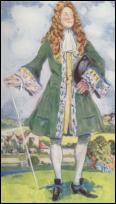
This costume history information consists of Pages 383-394 of the chapter on very late 17th century dress in the 13 YEAR REIGN era of William III and Mary 1689-1702 and taken from English Costume by Dion Clayton Calthrop.
The 36 page section consists of a text copy of the book ENGLISH COSTUME PAINTED & DESCRIBED BY DION CLAYTON
CALTHROP. Visuals, drawings and painted fashion plates in the book have a charm of their own and are shown amid the text. The book covers both male and female dress history of over 700 years spanning the era 1066-1830.
This page is about dress in the reign of William and Mary 1689-1702.
For the Introduction to this book see this introduction written by Dion Clayton Calthrop. I have adjusted the images so they can be used for colouring worksheets where pupils add some costume/society facts. My comments are in italics.

WILLIAM AND MARY Reigned thirteen years: 1689-1702. The King born in 1650; the Queen born in 1662; married in 1677.
THE MEN's Fashion During William and Mary's Period
First and foremost, the wig.
Periwig, peruke, campaign wig with pole-locks, all the rage, all the thought of the first gentlemen. Their heads loaded with curl upon curl, long ringlets hanging over their shoulders and down their backs, some brown, some covered with meal until their coats looked like millers' coats; scented hair, almost hiding the loose-tied cravat, 'most agreeably discoloured with snuff from top to bottom.'
Waistcoat, Stick, Wig & Hat
My fine gentleman walking the street with the square-cut coat open to show a fine waistcoat, his stick hanging by a ribbon on to his wrist and rattling on the pavement as it dragged along, his hat carefully perched on his wig, the crown made wide and high to hold the two wings of curls, which formed a negligent central parting.
His pockets, low down in his coat, show a lace kerchief half dropping from one of them. One hand is in a small muff, the other holds a fine silver-gilt box filled with Vigo snuff.
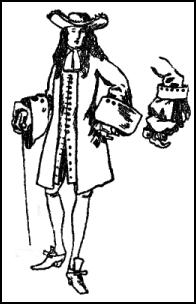
He wears high-heeled shoes, red heeled, perhaps, and the tongue of his shoe sticks up well above the instep.
Probably he is on his way to the theatre, where he will comb his periwig in public, and puff away the clouds of powder that come from it. The fair lady in a side box, who hides her face behind a mask, is delighted if Sir Beau will bow to her.
Artificiality is the Fashion
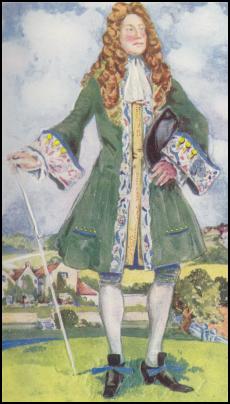
We are now among most precise people. One must walk here with just such an air of artificiality as will account one a fellow of high tone.
Taking A Pinch Of Snuff
The more enormous is our wig, the more frequently we take a pinch of Violet Strasburg or Best Brazil, Orangery, Bergamotte, or Jassamena, the more shall we be followed by persons anxious to learn the fashion.
Silver Spittoons
We may even draw a little silver bowl from our pocket, place it on a seat by us, and, in meditative mood, spit therein.
A MAN OF THE TIME OF WILLIAM AND MARY - 1689-1702
In this costume plate we can see the cuffs have become much broader and the skirt of the frock coat is wider too. The gentleman wears his coat left open to show the long waistcoat. Pride of place goes to his wig which is much fuller than earlier styles. Fussy ribbon strings hold the shoes onto his feet.
Big Coats & Semi Fitted Breeches
We have gone completely into skirted coats and big flapped waistcoats; we have adopted the big cuff buttoned back; we have given up altogether the wide knee-breeches, and wear only breeches not tight to the leg, but just full enough for comfort.
Men's Hats
The hats have altered considerably now; they are cocked up at all angles, turned off the forehead, turned up one side, turned up all round; some are fringed with gold or silver lace, others are crowned with feathers.
We hear of such a number of claret-coloured suits that we must imagine that colour to be all the rage, and, in contrast to other times not long gone by, we must stiffen ourselves in buckram-lined skirts.

The Huge Wigs
These powdered Absaloms could change themselves into very fine fighting creatures, and look twice as sober again when occasion demanded.
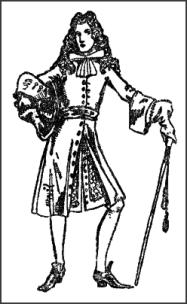
They rode about the country in periwigs, certainly, but not quite so bushy and curled; many of them took to the travelling or campaign wig with the pole-locks.
These wigs were full over the ears and at the sides of the forehead, but they were low in the crown, and the two front ends were twisted into single pipes of hair; or the pipes of hair at the side were entirely removed, and one single pipe hung down the back.
The custom of thus twisting the hair at the back, and there holding it with a ribbon, gave rise to the later pigtail. The periwigs so altered were known as short bobs, the bob being the fullness of the hair by the cheeks of the wig.
Wider Cuffs
The cuffs of the coat-sleeve varied to the idea and taste of the owner of the coat; sometimes the sleeve was widened at the elbow to 18 inches, and the cuffs, turned back to meet the sleeves, were wider still. Two, three, or even more buttons held the cuff back.
Pockets
The pockets on the coats were cut vertically and horizontally, and these also might be buttoned up.
Coat Buttons

Often the coat was held by only two center buttons, and the waistcoat flaps were not buttoned at all. The men's and women's muffs were small, and often tied and slung with ribbons.
Plain round riding coats were worn, fastened by a clasp or a couple of large buttons.
Neckcloths
The habit of tying the neckcloth in a bow with full hanging ends was dying out, and a more loosely tied cravat was being worn; this was finished with fine lace ends, and was frequently worn quite long.
Mens Stockings
Stockings were pulled over the knee, and were gartered below and rolled above it.
The ordinary citizen wore a modified edition of these clothes - plain in cut, full, without half the number of buttons, and without the tremendous periwig, wearing merely his own hair long.
For convenience in riding, the skirts of the coats were slit up the back to the waist; this slit could be buttoned up if need be.
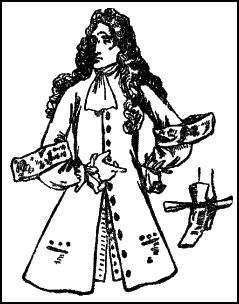
The Dandy
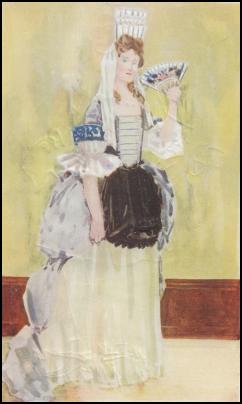
Now, let us give the dandy of this time his pipe, and let him go in peace. Let us watch him stroll down the street, planting his high heels carefully, to join two companions outside the tobacco shop.
Here, by the great carved wood figure of a smoking Indian with his kilt of tobacco leaves, he meets his fellows. From the hoop hung by the door one chooses a pipe, another asks for a quid to chew and a spittoon, the third calls for a paper of snuff newly rasped.
Then they pull aside the curtains and go into the room behind the shop, where, seated at a table made of planks upon barrels, they will discuss the merits of smoking, chewing, and snuffing.
'We three are engaged in one cause,I snuffs, I smokes, and I chaws.'
A WOMAN OF THE TIME OF WILLIAM AND MARY - 1689-1702
Here you see the cap called the 'fontage,' the black silk apron, the looped skirt, and the hair on the high frame called a 'commode.'
Let me picture for you a lady of this time in the language of those learned in dress, and you will see how much it may benefit.
'We see her coming afar off; against the yew hedge her weeds shine for a moment. We see her figuretto gown well looped and puffed with the monte-la-haut. Her échelle is beautiful, and her pinner exquisitely worked. We can see her commode, her top-not, and her fontage, for she wears no rayonné.
A silver pin holds her meurtriers, and the fashion suits better than did the crève-cœurs. One hand holds her Saxon green muffetee, under one arm is her chapeau-bras. She is beautiful, she needs no plumpers, and she regards us kindly with her watchet eyes.'
A lady of this date would read this and enjoy it, just as a lady of to-day would understand modern dress language, which is equally peculiar to the mere man. For example, this one of the Queen of Spain's hats from her trousseau (curiously enough a trousseau is a little bundle):
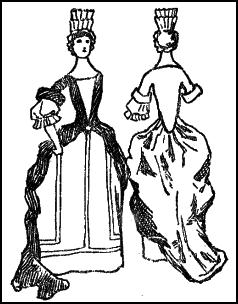
'The hat is a paille d'Italie trimmed with a profusion of pink roses, accompanied by a pink chiffon ruffle fashioned into masses bouillonnée arranged at intervals and circled with wreaths of shaded roses.'
The modern terms so vaguely used are shocking, and the descriptive names given to colours by dress-artists are horrible beyond belief - such as Watteau pink and elephant grey, not to speak of Sèvres-blue cherries.
However, the female mind delights in such jargon and hotch-potch.
Let me be kind enough to translate our William and Mary fashion language.
Weeds
'Weeds' is a term still in use in 'widow's weeds,' meaning the entire dress appearance of a woman.
Figueretto
A 'figuretto gown looped and puffed with the monte-la-haut' is a gown of figured material gathered into loops over the petticoat and stiffened out with wires 'monte-la-haut.'
Échelle
The 'échelle' is a stomacher laced with ribbons in rungs like a ladder.
Pinner
Her 'pinner' is her apron.
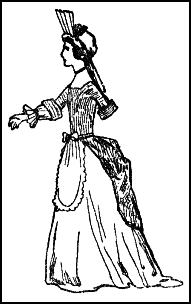
Commode, Top-Not, Fontage Tower
The 'commode' is the wire frame over which the curls are arranged, piled up in high masses over the forehead.
The 'top-not' is a large bow worn at the top of the commode; and the 'fontage' or 'tower' is a French arrangement of alternate layers of lace and ribbon raised one above another about half a yard high.
It was invented in the time of Louis XIV, about 1680, by Mademoiselle Fontage.
Rayonné
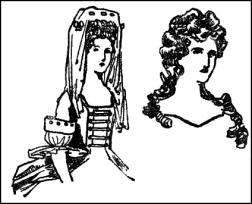
The 'rayonné' is a cloth hood pinned in a circle.
Meurtriers
The 'meurtriers,' or murderers, are those twists in the hair which tie or unloose the arrangements of curls; and the 'crève-cœurs' are the row of little forehead curls of the previous reign.
Muffetee & Chapeau-bras
A 'muffetee' is a little muff, and a 'chapeau-bras' is a hat never worn, but made to be carried under the arm by men or women; for the men hated to disarrange their wigs.
Plumpers
'Plumpers' were artificial arrangements for filling out the cheeks, and 'watchet' eyes are blue eyes.
Side Panniers
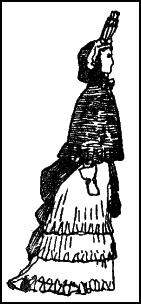
The ladies have changed a good deal by the middle of this reign: they have looped up the gown till it makes side-panniers and a bag-like droop at the back; the under-gown has a long train, and the bodice is long-waisted.
The front of the bodice is laced open, and shows either an arrangement of ribbon and lace or a piece of the material of the under-gown.
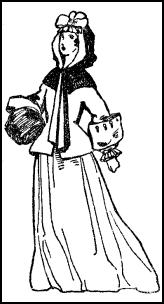
Black pinners in silk with a deep frill are worn as well as the white lace and linen ones.
The ladies wear short black capes of this stuff with a deep frill.
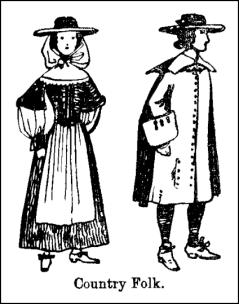
Sometimes, instead of the fontage, a lady wears a lace shawl over her head and shoulders, or a sort of lace cap bedizened with coloured ribbons.
Her sleeves are like a man's, except that they come to the elbow only, showing a white under-sleeve of lace gathered into a deep frill of lace just below the elbow.
She is very stiff and tight-laced, and very long in the waist; and at the waist where the gown opens and at the loopings of it the richer wear jeweled brooches.
Later in the reign there began a fashion for copying men's clothes, and ladies wore wide skirted coats with deep-flapped pockets, the sleeves of the coats down below the elbow and with deep-turned overcuffs. They wore, like the men, very much puffed and ruffled linen and lace at the wrists.
Also they wore men's waistcoat fashions, carried sticks and little arm-hats - chapeau-bras.
To complete the dress the hair was done in a bob-wig style, and the cravat was tied round their necks and pinned. For the winter one of those loose Dutch jackets lined and edged with fur, having wide sleeves.
The Dutch Look
The general tendency was to look Dutch, stiff, prim, but very prosperous; even the country maid in her best is close upon the heel of fashion with her laced bodice, sleeves with cuffs, apron, and high-heeled shoes.
You have been reading English Costume History at www.fashion-era.com © from the chapter William and Mary 1689-1702, from Dion Clayton Calthrop's book English Costume.
Page Added 16 August 2010. Ref:-812.